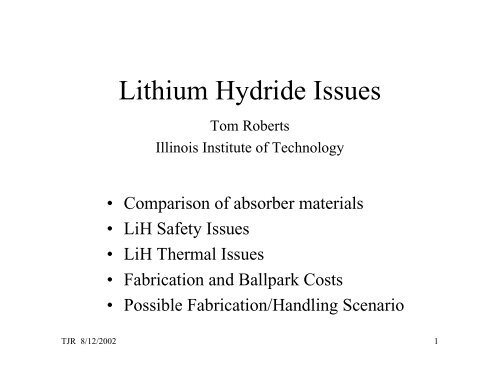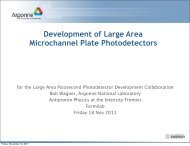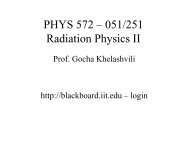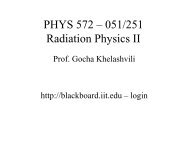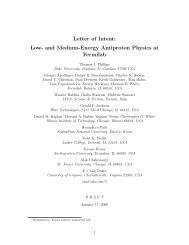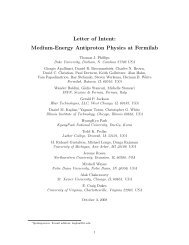Lithium Hydride Issues - Capp.iit.edu - Illinois Institute of Technology
Lithium Hydride Issues - Capp.iit.edu - Illinois Institute of Technology
Lithium Hydride Issues - Capp.iit.edu - Illinois Institute of Technology
You also want an ePaper? Increase the reach of your titles
YUMPU automatically turns print PDFs into web optimized ePapers that Google loves.
<strong>Lithium</strong> <strong>Hydride</strong> <strong>Issues</strong><br />
Tom Roberts<br />
<strong>Illinois</strong> <strong>Institute</strong> <strong>of</strong> <strong>Technology</strong><br />
• Comparison <strong>of</strong> absorber materials<br />
• LiH Safety <strong>Issues</strong><br />
• LiH Thermal <strong>Issues</strong><br />
• Fabrication and Ballpark Costs<br />
• Possible Fabrication/Handling Scenario<br />
TJR 8/12/2002 1
1.2<br />
1<br />
0.8<br />
0.6<br />
0.4<br />
0.2<br />
0<br />
Comparison <strong>of</strong> Absorber Materials<br />
Transverse Cooling Effectiveness<br />
2<br />
Fcool GH2 LH2 LHe LiH Li CH4 Be B C Al<br />
TJR 8/12/2002 2
Definition <strong>of</strong> F cool<br />
F cool is the fractional Energy-loss per radiation length.<br />
The standard equation for Ionization cooling <strong>of</strong> transverse emittance:<br />
dε<br />
1<br />
= − 2<br />
ds β<br />
dE<br />
ds<br />
ε 1<br />
+ 2<br />
E β<br />
2<br />
β ⊥(<br />
0.<br />
014)<br />
2E<br />
m LR<br />
At equilibrium:<br />
ε =<br />
¤¢¥<br />
2<br />
β⊥<br />
( 0.<br />
014)<br />
E β⊥<br />
( 0.<br />
014)<br />
1<br />
≡<br />
2E<br />
m dE 2E<br />
m F cool<br />
LR<br />
ds<br />
¦<br />
£<br />
¢¡<br />
Fcool characterizes the absorber material; the brackets characterize the<br />
lattice and kinematics. This ignores variations in β ⊥ over the varying<br />
thicknesses <strong>of</strong> the different absorber materials (which can be important,<br />
especially for LH2 windows). The 4-d transverse cooling effectiveness is<br />
the square <strong>of</strong> Fcool.<br />
TJR 8/12/2002 3<br />
¤¢¥<br />
¦<br />
2<br />
£<br />
¢¡
LiH Safety <strong>Issues</strong><br />
• LiH is a hazardous material; the safety issues are very different<br />
from those <strong>of</strong> liquid Hydrogen, but roughly comparable in<br />
difficulty.<br />
• LiH reacts violently with water, so water cooling must be<br />
carefully designed and implemented (it’s not certain it can be<br />
done safely). Halon fire suppression is probably required.<br />
• Handling <strong>of</strong> prefabricated LiH is not terribly hazardous<br />
(gloves and dust masks); fabrication itself (casting) is best left<br />
to experts.<br />
• Bare LiH can be pumped down to vacuum; it is best to repressurize<br />
with dry Nitrogen, but room air is OK.<br />
• LiH cannot be in direct contact with aluminum (Al migrates).<br />
TJR 8/12/2002 4
LiH Thermal <strong>Issues</strong><br />
• Water cooling must be carefully designed and implemented, and<br />
may not be possible safely.<br />
• LN 2 cooling seems a better choice than water (much higher<br />
thermal conductivity, lack <strong>of</strong> safety concerns), and may be<br />
desirable for r<strong>edu</strong>cing RF power I 2 R dissipation, also.<br />
• LiH is a pretty good conductor <strong>of</strong> heat – if good thermal<br />
conductivity to the mounting flange can be achieved, then edge<br />
cooling may be good enough for a linear channel, but not for a<br />
cooling ring (see below). But how do we achieve this (remember<br />
their thermal expansion rates are significantly different)?<br />
• For optimistic intensities there will be large temperature<br />
gradients – will thermally-induced stresses be a problem?<br />
• Radiation cooling is tiny compared to conduction.<br />
• But LiH thermal properties are not very well known....<br />
TJR 8/12/2002 5
Thermal Properties <strong>of</strong> LiH<br />
• From 293 K to 80 K, LiH contracts about 20% more than Al.<br />
• LiH melts at 956 K.<br />
• LiH thermal conductivity is not well known (varies with<br />
preparation?):<br />
Watt/cm/K<br />
0.35<br />
0.3<br />
0.25<br />
0.2<br />
0.15<br />
0.1<br />
0.05<br />
0<br />
LiH Thermal Conductivity<br />
0 200 400 600 800 1000<br />
Temperature (K)<br />
Data 1<br />
Data 3<br />
Data 4<br />
Data 13<br />
Data 14<br />
Fit to 13<br />
Melt. Pt.<br />
TJR 8/12/2002 6
LiH Absorber Properties in a Cooling Channel<br />
• Values are for a 5 cm thick 30 cm diameter LiH absorber (7.5<br />
MeV loss) with edge at 80 K.<br />
• Thermal conductivity assumed constant, estimated from above<br />
fit, for temperature ~20% below peak.<br />
• Heating power and temperature rise both scale with intensity and<br />
with turns around a cooling ring.<br />
• Half-aperture wedge absorbers will have significantly less<br />
heating power and lower peak temperatures (depends on details).<br />
Beam<br />
mu/sec<br />
4×10 14<br />
4×10 14<br />
4×10 14<br />
4×10 14<br />
Ring Beam Sigma Heating Peak<br />
Turns<br />
Power Temp.<br />
1 5 cm 482 W 145 K<br />
1 2 cm 482 W 530 K<br />
1 1 cm 482 W Melts<br />
10 5 cm => 3 cm 4.8 kW Melts<br />
TJR 8/12/2002 7
LiH Fabrication and Ballpark Costs<br />
• LiH is readily available,
Possible Fabrication/Handling Scenario<br />
• We machine stainless steel mounting flanges and safety<br />
covers, and ship them to the LiH supplier; safety covers will<br />
also provide support during shipping and handling.<br />
• The supplier casts the LiH to fit, installs it in the flanges,<br />
attaches the covers in the dry room, and ships to FNAL.<br />
• Except for acceptance inspection (in a fume hood), the covers<br />
are left in place until mounted into the beamline.<br />
• The last task before sealing the vacuum pipe is to remove the<br />
covers; the beamline is then pumped down as usual.<br />
• When the beamline needs to be opened for maintenance, it is<br />
pressurized with dry N 2; after opening, the first task is to<br />
reattach the covers.<br />
• In an emergency or accident, using room air to pressurize is<br />
OK (at worst the surface <strong>of</strong> the LiH will oxidize a bit).<br />
TJR 8/12/2002 9
Possible Fabrication/Handling Scenario<br />
• Lots <strong>of</strong> those steps still need to be investigated:<br />
– How do we achieve good thermal contact between LiH and flange?<br />
– Will shipping fracture or crumble the LiH?<br />
– Use <strong>of</strong> a fume hood for acceptance inspection – is one available? Can it<br />
be flooded with dry N 2 ?<br />
– Even with covers in place should it be stored in a special dry room?<br />
– Can the beamline even be designed so the covers can be removed last?<br />
– How do we repressurize the beamline with dry N 2 ?<br />
– How much room moisture will get to the LiH before the covers are reattached?<br />
– clearly this depends upon how much work is involved to<br />
get to the LiH to attach them.<br />
– How do we ensure the fire department never uses water near LiH? I<br />
assume Halon fire suppression systems will be used....<br />
– Surface oxidation from air moisture is almost inevitable; how will it<br />
affect the cooling performance?<br />
• All <strong>of</strong> this needs to be reviewed and approved.<br />
TJR 8/12/2002 10


